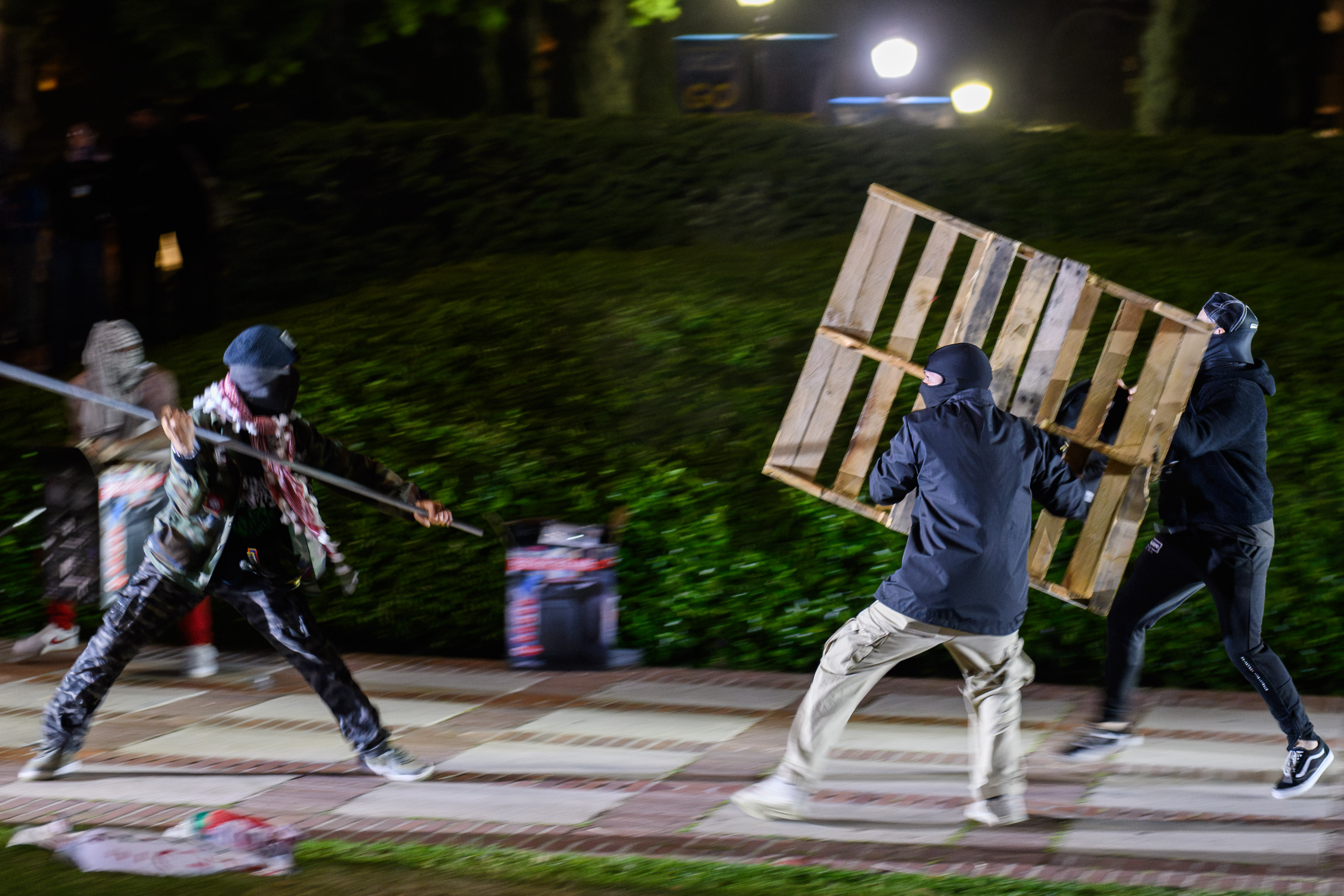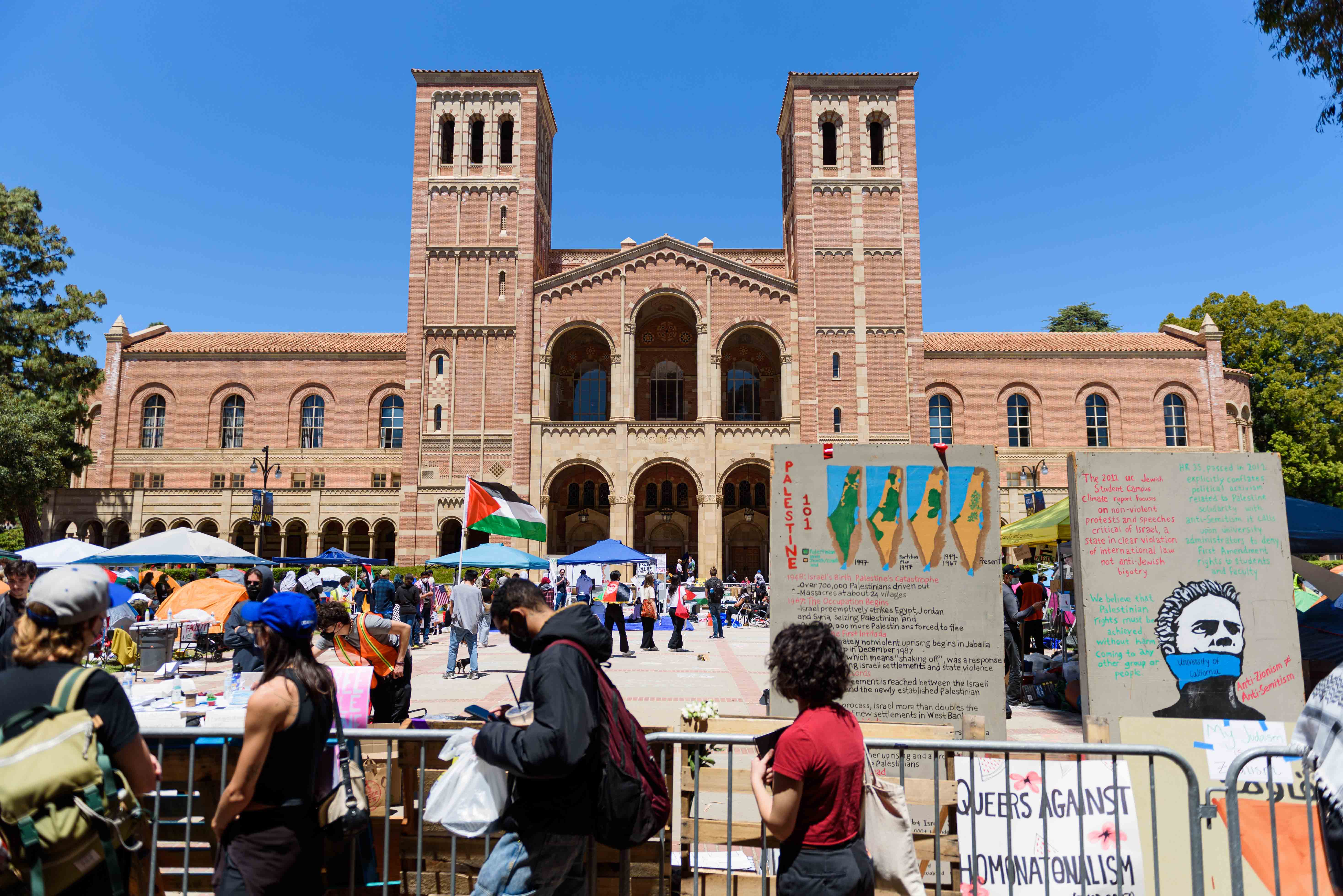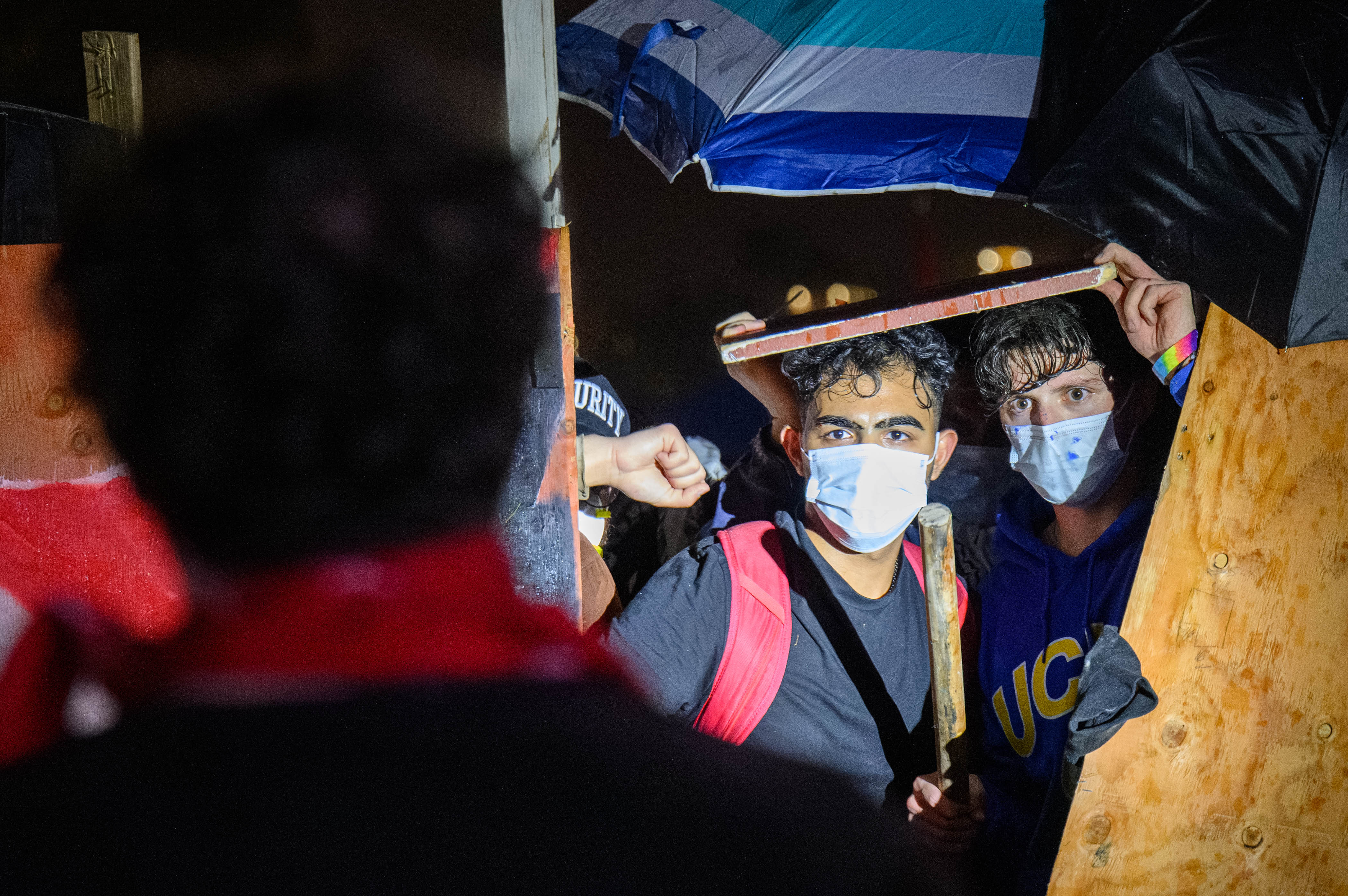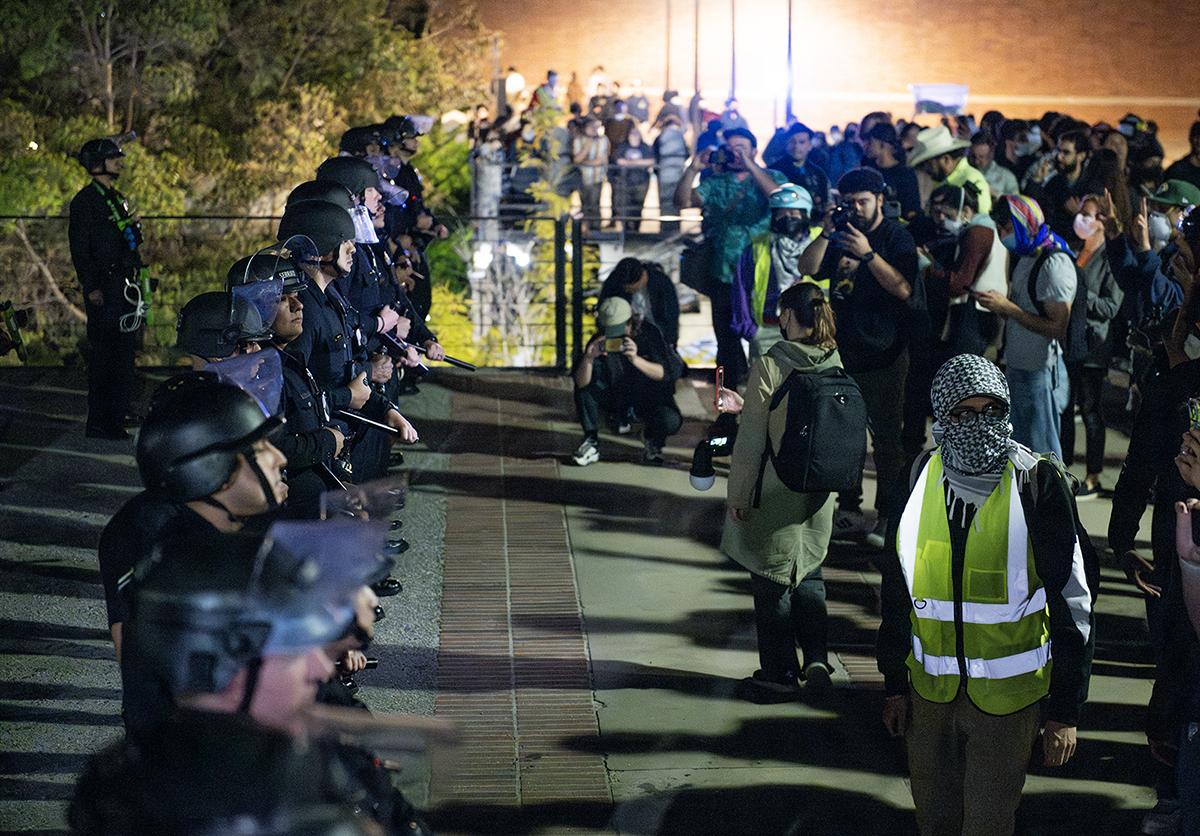Volunteer medics are pictured organizing supplies at the foot of Janss Steps on the afternoon of May 1. Dozens of medics, ranging from undergraduates to hospital physicians, staffed the now-dismantled Palestine solidarity encampment during the April 30 attack and the May 2 police sweep. (Anna Dai-Liu/Daily Bruin senior staff)
By Anna Dai-Liu
May 14, 2024 at 8:26 p.m.
This post was updated May 14 at 11:29 p.m.
For the Daily Bruin’s full coverage of the UC Divest Coalition and Students for Justice in Palestine at UCLA demonstrations, see here.
“Blunt injuries, from what sounded like planks of wood or pieces of metal.”
“Injuries to the head, injuries to the airway.”
“Eyes burning, face burning, skin burning from tear gas and mace.”
“Cuts, bruises and burns – those were normalized at that point.”
All of these injuries appeared in the span of less than 36 hours, medics said, as the now-dismantled Palestine solidarity encampment at UCLA was violently attacked April 30 by around 100 aggressors – wielding poles, aerosol irritants and their fists – and then forcefully swept by police deploying rubber bullets and flash bangs in the early hours of May 2.
Throughout those 36 hours, dozens of volunteer medics, ranging from first aid-certified undergraduates to hospital nurses, were present. One of them was third-year political science student David Orlinsky.
“The sky was lighting up above us from the flash bangs,” said Orlinsky, who was near the encampment the night of the police sweep. “Couple that with people bleeding from the head running at you – it’s not something you ever expect to see on your college campus, especially somewhere where people are usually laying out in the sun or eating their food.”
Over the course of the attack and police sweep, hundreds were arrested and dozens were injured. Orlinsky said he believes reported injury numbers are an underestimate, as some minor injuries were never accounted for and other people refused to seek professional medical care out of fear that their involvement in the protest would be documented.
Medics were located across campus, with some stationed in Portola Plaza near the encampment and others below Janss Steps, he said. Orlinsky said he was stationed the night of the sweep in Kaufman Hall, where medics set out supplies and a triage center. However, an unidentified person suddenly sprayed a fire extinguisher, forcing his team to evacuate with limited supplies and set up on the grass outside the building, he added.
Some students were injured to the extent that they required hospital care. As word came in of the April 30 attack, those on standby in the Ronald Reagan UCLA Medical Center’s emergency department watched livestreams – something that Physician A, an emergency physician who was granted anonymity for fear of retaliation from UCLA Health, said was “dystopian.”
[Related: Pro-Israel counter-protesters attempt to storm encampment, sparking violence]
Physician A, who was on shift in the emergency department the nights of April 30 and May 1, added that while hospital staff had been preparing for protest-related injuries, they did not anticipate anything as severe as what actually occurred.
During “mass casualty incidents” like the April 30 attack, all incoming ambulance traffic is diverted to other hospitals and all walk-in patients are admitted, added Physician B – an emergency medicine physician at UCLA who was granted anonymity for fear of retaliation from counter-protesters.
One patient had a heart injury from the severity of the hits they sustained to the chest, while another would require surgery because of the damage done to part of a bone in their hand, Physician A later wrote in a text message to The Bruin.
“A lot of the patients who came in were so young, and a lot of them were, I assume to be, students at UCLA,” they said. “We do see a lot of traumatic injuries in the ED (emergency department), but in the context of this protest and being on the national stage, I think it was an unbelievable experience.”
[Related: ‘I thought I was going to die’: UCLA encampment protesters recall April 30 attack]
Multiple weapons used by police during the sweep – including tear gas, rubber bullets and flash bangs – are officially categorized as less-than-lethal. However, the consequences of these devices are far from non-lethal, said Dr. Utpal Sandesara, an assistant professor-in-residence in the department of internal medicine and the International Institute’s global health program.
For example, the sensory overstimulation caused by a flash bang is akin to a “near-death” experience that can cause lasting trauma, he said. Rubber bullets – which are supposed to be aimed at the legs – can be lethal in certain circumstances, as they tend to fly in unpredictable directions, he added.
“I’ve heard people even compare them to toy projectiles, but these are anything but,” Sandesara said.
Physician A said they do not believe the less-than-lethal categorization captures the dangerous nature of these weapons.
“I don’t think they should be categorized as non-lethal, especially given the nature of the injuries of some of these patients that came into our emergency department,” they said. “Taking a hit from a rubber bullet to the head can definitely end someone’s life.”
Multiple doctors expressed concerns about people in the encampment being afraid to seek out professional medical care. Some of the injuries caused by rubber bullets, for example, can lead to severe consequences if untreated, Sandesara said.
Physician B, who volunteered as a medic during the April 30 attack, added that they treated one student having an asthma attack, but the student refused to walk to the emergency room out of fear of being assaulted by counter-protesters on the way there.
Orlinsky said he believed the medics present were there purely because they wanted to help. Watching students from diverse backgrounds come together for a common cause helped restore his faith in humanity, he said.
“On our medic staff, there were Christian students. There were Jewish students. There were Muslim students,” Orlinsky said. “Everyone, again, did an outstanding job of coming together and setting all of our differences aside to just treat people.”
Some of the physicians said their roles as doctors made it even more difficult to see the violence enacted against community members, as well as those in the Gaza Strip.
Over 250 faculty members, including some physicians, signed a letter in December calling on the university to protect Palestinian community members and those expressing solidarity with them. Sandesara, who signed the letter, said violence of any scale – whether the Oct. 7 Hamas-led attack that killed around 1,200 Israelis, the killing and displacement of tens of thousands of Palestinians by the Israeli military, or the attacks on UCLA students and faculty April 30 – is heartbreaking for him to see as a health care provider.
Physician B, who also signed the letter, said their role as an emergency physician is fundamental to their opposition to Israel’s ongoing siege in the Gaza Strip.
“In emergency medicine, we confront needless death – unexpected death – all the time, and just having one child die on a shift is heartbreaking and devastating and takes a while to emotionally process. And so to see 35,000 human beings, the vast majority of whom are women and children, dying in 200 some-odd days is taking that emotional distress and magnifying it a thousandfold,” they said. “Being that I am an emergency medicine physician, I believe that it is incumbent upon me to advocate against this kind of wanton and senseless violence against other human beings. I don’t think that I very well could call myself an emergency physician, let alone a physician, and not advocate against this kind of killing.”
Physician B also criticized the university’s differing responses April 30 and May 1. Police did not arrive on the night of the attack on the encampment until hours after violence began, and when they did arrive, they initially did not engage with counter-protesters. Hundreds of law enforcement officers from various police forces then mobilized for the following night’s sweep.
“UCLA could not manage to marshal law enforcement to protect their students,” Physician B said. “But they could mobilize law enforcement to shoot rubber bullets at their students.”
[Related: Hundreds of protesters detained after police breach pro-Palestine encampment at UCLA]
Physician A said they also have questions about the role of police when it comes to protests and more general situations, as both inaction and action from officers resulted in violence. They said they saw the violence that occurred both nights as largely one-sided, adding that the patients they saw were protesters from inside the encampment or UCLA-employed security guards – but no counter-protesters or police.
Sandesara said he thought the violence – which he said was implicitly condoned by administrative officials who labeled the encampment as “unlawful” – was unnecessary and unjust. Chancellor Gene Block is currently the subject of UCLA Academic Senate votes to censure and of no confidence for his response to the encampment.
Physician B said they view the administration’s actions as shameful and reflective of its inability to protect the campus community.
“There were students that had head bleeds, brain bleeds from those rubber bullets. There were students that had such significant fractures from those rubber bullets that they were in danger of losing a finger,” they said. “Those are not actions of people interested in student safety. Whatever letter that Chancellor Block wants to issue stating that these are his goals – his actions do not reflect his words.”




